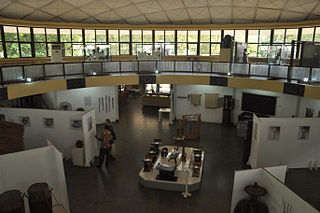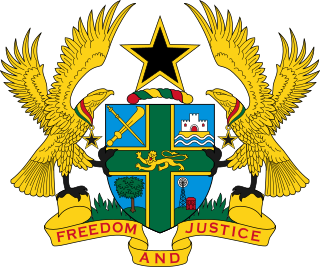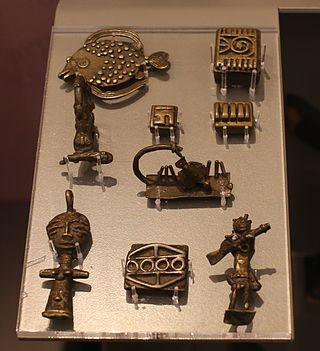
Jewellery consists of decorative items worn for personal adornment, such as brooches, rings, necklaces, earrings, pendants, bracelets, and cufflinks. Jewellery may be attached to the body or the clothes. From a western perspective, the term is restricted to durable ornaments, excluding flowers for example. For many centuries metal such as gold often combined with gemstones, has been the normal material for jewellery, but other materials such as glass, shells and other plant materials may be used.

A necklace is an article of jewellery that is worn around the neck. Necklaces may have been one of the earliest types of adornment worn by humans. They often serve ceremonial, religious, magical, or funerary purposes and are also used as symbols of wealth and status, given that they are commonly made of precious metals and stones.

African art describes the modern and historical paintings, sculptures, installations, and other visual culture from native or indigenous Africans and the African continent. The definition may also include the art of the African diasporas, such as: African-American, Caribbean or art in South American societies inspired by African traditions. Despite this diversity, there are unifying artistic themes present when considering the totality of the visual culture from the continent of Africa.

Kente refers to a Ghanaian textile made of hand-woven strips of silk and cotton. Historically the fabric was worn in a toga-like fashion by royalty among the Ewe and Akan. According to Ashanti oral tradition, it originated from Bonwire in the Ashanti region of Ghana. In modern day Ghana, the wearing of kente cloth has become widespread to commemorate special occasions, and kente brands led by master weavers are in high demand. Kente is also worn in parts of Togo and Ivory Coast by the Ewe and Akan people there.
The Akan people are a Kwa group living primarily in present-day Ghana and in parts of Ivory Coast and Togo in West Africa. The Akan speak dialects within the Central Tano branch of the Potou–Tano subfamily of the Niger–Congo family. Subgroups of the Akan people include: the Agona, Akuapem, Akwamu, Akyem, Anyi, Ashanti, Baoulé, Bono, Chakosi, Fante, Kwahu, Sefwi, Wassa, Ahanta, and Nzema, among others. The Akan subgroups all have cultural attributes in common; most notably the tracing of matrilineal descent in the inheritance of property, and for succession to high political office.
The diverse culture of Ivory Coast, a coastal West African country bordered by Ghana, Liberia, Mali, Burkina Faso, and Guinea, is exemplified by a multitude of ethnic groups, events, festivals, music, and art.
Bono State was a trading state created by the Bono people, located in what is now southern Ghana. Bonoman was a medieval Akan kingdom in what is now Bono, Bono East and Ahafo region respectively named after the and Eastern Ivory Coast. It is generally accepted as the origin of the subgroups of the Akan people who migrated out of the state at various times to create new Akan states in search of gold. The gold trade, which started to boom in Bonoman as early in the 12th century, was the genesis of Akan power and wealth in the region, beginning in the Middle Ages.

The National Museum of Ghana is in the Ghanaian capital, Accra. It is the largest and oldest of the six museums under the administration of the Ghana Museums and Monuments Board (GMMB).

Adinkra are symbols from Ghana that represent concepts or aphorisms. Adinkra are used extensively in fabrics, logos and pottery. They are incorporated into walls and other architectural features. Adinkra symbols appear on some traditional Akan goldweights. The symbols are also carved on stools for domestic and ritual use. Tourism has led to new departures in the use of symbols in items such as T-shirts and jewellery.

The Golden Stool is the royal and divine throne of kings of the Ashanti people and the ultimate symbol of power in Asante. According to legend, Okomfo Anokye, High Priest and one of the two chief founders of the Asante Confederacy, caused the stool to descend from the sky and land on the lap of the first Asante king, Osei Tutu. Such seats were traditionally symbolic of a chieftain's leadership, but the Golden Stool is believed to house the spirit of the Asante nation—living, dead and yet to be born.

The coat of arms of Ghana was designed by Ghanaian artist Nii Amon Kotei and was introduced on 4 March 1957.

Sankofa is a word in the Twi language of Ghana meaning “to retrieve" and also refers to the Bono Adinkra symbol represented either with a stylized heart shape or by a bird with its head turned backwards while its feet face forward carrying a precious egg in its mouth. Sankofa is often associated with the proverb, “Se wo were fi na wosankofa a yenkyi," which translates as: "It is not wrong to go back for that which you have forgotten."
In many parts of West Africa, there is an old chieftaincy tradition, and the Akan people have developed their own hierarchy, which exists alongside the democratic structure of the country. The Akan word for the ruler or one of his various courtiers is "Nana". In colonial times, Europeans translated it as "chief", but that is not an exact equivalent. Other sources speak of "kings", which is also not entirely correct, especially in the case of the said courtiers. The term "chief" has become common even among modern Ghanaians, though it would be more correct to use the expression "Nana" without translation wherever possible.

Akan goldweights are weights made of brass used as a measuring system by the Akan people of West Africa, particularly for wei and fair-trade arrangements with one another. The status of a man increased significantly if he owned a complete set of weights. Complete small sets of weights were gifts to newly wedded men. This insured that he would be able to enter the merchant trade respectably and successfully.

An Akrafena is an Ashanti sword, originally meant for warfare but also forming part of Ashanti heraldry. The foremost example of an akrafena is the Mponponsuo, which belonged to Opoku Ware II. It has survived to the present day because it is still occasionally used in ceremonies, such as the Akwasidae Festival.

Luba art refers to the visual and material culture of the Luba people. Most objects were created by people living along the Lualaba River and around the lakes of the Upemba Depression, or among related peoples to the east in what is now the Democratic Republic of the Congo.
Osram ne nsoromma is one of the Bono Adinkra symbols, which is interpreted to mean "Osram" Moon "Ne" and "Nsoromma" Star. This symbol signifies love, bonding and faithfulness in marriage. The symbol is represented by a half moon with a star slightly hanging within the circumference of the moon. Adinkra are symbols that carry a message or a concept. They are very much used by the Bono people of the Bonoman and the Gyaman, an Akan people of Ghana and Côte d'Ivoire. Osram ne nsoromma symbols are incorporated into walls and other architectural features and quite recently has become common with tattoo designers. The most common ways through which the Adinkra messages are carried out or conveyed is having them printed extensively in fabrics and used in pottery.
Osei Bonsu was a Ghanaian sculptor and practitioner of Ashanti carving.

The traditionalGhanaian stool is a carved wooden stool common in sub-Saharan West Africa, and especially common in Ghana. Among the Akan it is used as a household object, it is used in rites of passage, and is considered sacred.
The political organization of the historical Ashanti Empire was characterized by stools which denoted "offices" that were associated with a particular authority. The Golden Stool was the most powerful of all, because it was the office of the King of the Ashanti Empire. Scholars such as Jan Vansina have described the governance of the Ashanti Empire as a federation where state affairs were regulated by a council of elders headed by the king, who was simply primus inter pares.



























